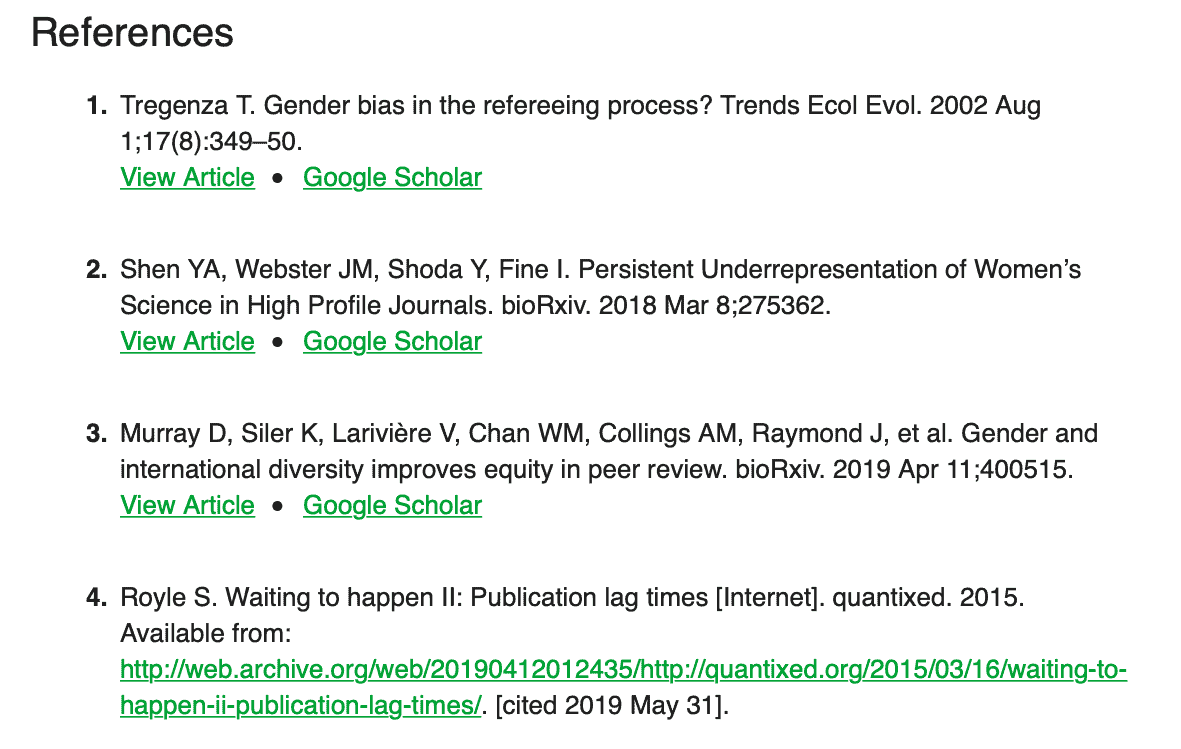We sometimes get queries about whether preprints can be cited in journal publications, and while we make a brief mention to this in our FAQ, we thought it would be useful to offer a deeper dive. We believe it is important for articles to give credit to any sources the authors used as part of the conceptualization, development or interpretation of their work, independent of the scope or peer-reviewed status of the research object. Preprints are legitimate research outputs and should be afforded fair credit and attribution in the context of citation practice.
The importance of giving credit
There have been different points of view expressed about what the goal of the reference list is and on whether non-peer reviewed materials should be included there [1]. In a broad sense, the reference list provides information on the source of specific statements or entities mentioned in the article, credit for the authors of the source and information for readers on how to retrieve that source, should they wish to read, reuse or scrutinize it further. From that perspective, it makes sense to include in the reference list any objects that the author has used to support the statement or claim, provided that there is a source to refer to.
Some have suggested that preprints could be mentioned in the text in the same manner as ‘personal communications’, however, the latter often refers to individual exchanges with another scientist or presentations at a conference for which there is no permanent or public record. Preprints are publicly available permanent records of scholarly work and as a result; if they are used or built upon, good scholarship calls for giving credit to that source and to provide the full details of this in the reference list so that it is available to readers. This approach is not exclusive to preprints: the same applies to other non-peer reviewed objects such as datasets, theses, code or government reports.
Journal policies
While there is no overarching standard across journals about whether preprints can be included in the references section, and variation exists across disciplines, a majority of the journals in the life sciences accept the citation of preprints in the reference list of their publications.
Journals in the physical sciences have operated alongside preprints in arXiv for decades and it is common for arXiv preprints to be cited. Given that the use of preprints in the life sciences was relatively rare until recent years, some journals had operated policies that excluded preprints from the reference list; however, there are examples of journals that have revisited their position in the context of higher preprint adoption, and have reverted their policy to now accept citation of preprints in the reference list [2].
Several publishers such as Nature Research, PLOS or Wiley have issued consolidated policies around the citation of preprints; these are great resources for authors and we would encourage journals to take additional steps in providing transparency around their policies, as a recent analysis of 171 academic journals across a range of disciplines reported that a majority of them (57.3%) did not specify public policies on whether citation of preprints is possible, although there were wide differences per discipline with the life and earth sciences being the group that had a highest proportion of journals with a designated policy allowing citation of preprints [3].
So in what format?
What format should be used to cite preprints? This has also been the subject of debate, and different organizations have different specific format requirements. The NIH issued guidelines for the reporting of preprints and other interim products in 2017, which outlined that the citation should indicate the preprint status of the paper, the DOI, the document version and the date the preprint is being cited, example below:
Example: Bar DZ, Atkatsh K, Tavarez U, Erdos MR, Gruenbaum Y, Collins FS. Biotinylation by antibody recognition- A novel method for proximity labeling. BioRxiv 069187 [Preprint]. August 11, 2016 [cited 2017 Jan 12]. Available from: https://doi.org/10.1101/069187.
The policy at Nature Research journals requires the designation of preprint status and the provision of the url at which the preprint is available. In addition, some journals require that the citation includes the disclaimer ‘not peer reviewed’ [2], in order to provide some further context regarding the certification status of the source and to signal that the process differs for a preprint vs that for a peer-reviewed journal article.
Given that journals often outline specific format requirements for submissions, a good recommendation is to check the Instructions for authors guidelines of the journal of interest to see if they outline specific requirements in relation to the citation of preprints.
The prevailing position among journals in the life sciences is to allow citation of preprints in the reference list, we encourage journals that do not currently have dedicated guidelines to add such information to their public editorial policies. Transparent preprint citation practices allow authors to provide fair attribution to work they have used as part of the development of their paper and also facilitate further research into the use and impact of preprints in the communication of research.
- David Crotty. ‘Preprints and Citations: Should Non-Peer Reviewed Material Be Included in Article References?‘ The Scholarly Kitchen.
- Barry L Stoddard, Keith R Fox, Editorial: Preprints, citations and Nucleic Acids Research, Nucleic Acids Research, Volume 47, Issue 1, 10 January 2019, Pages 1–2, https://doi.org/10.1093/nar/gky1229
- Peer review and preprint policies are unclear at most major journals. Thomas Klebel, Stefan Reichmann, Jessica Polka, Gary McDowell, Naomi Penfold, Samantha Hindle, Tony Ross-Hellauer. bioRxiv 2020.01.24.918995; doi: https://doi.org/10.1101/2020.01.24.918995








3 Comments